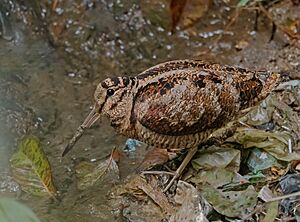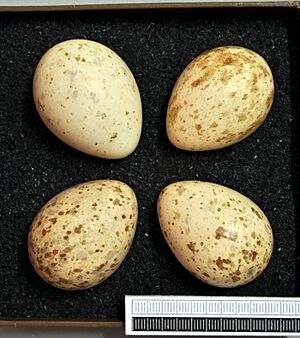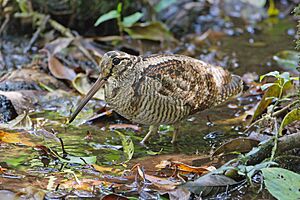Eurasian woodcock facts for kids
Quick facts for kids Eurasian woodcock |
|
|---|---|
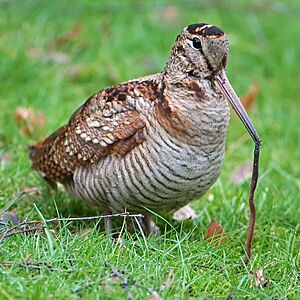 |
|
| Conservation status | |
| Scientific classification | |
| Genus: |
Scolopax
|
| Species: |
rusticola
|
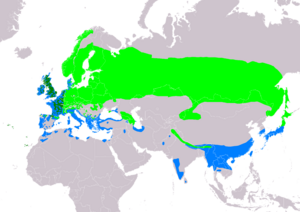 |
|
| Range of S. rusticola Breeding Resident Non-breeding | |
The Eurasian woodcock (Scolopax rusticola) is a medium-sized wading bird. It lives in forests across Europe and Asia. This bird is a master of camouflage! Its reddish-brown feathers with patterns help it blend in perfectly with its woodland home. Its eyes are set far back on its head, giving it amazing 360-degree vision. It uses its long, sensitive beak to probe the ground for food. This makes it hard for them to find food when the ground is frozen in cold weather.
Male woodcocks perform a special flight called "roding" at dusk in spring to attract females. Some people believe female woodcocks can carry their chicks while flying, but this has not been proven. There are about 14 to 16 million Eurasian woodcocks in the world.
Contents
About the Eurasian Woodcock's Name
The Eurasian woodcock got its official name, Scolopax rusticola, from a Swedish scientist named Carl Linnaeus in 1758. He wrote about it in his book Systema Naturae. The first part of its name, Scolopax, is a Latin word for a snipe or woodcock. The second part, rusticola, is a Latin name for a game bird.
This bird is a single species, meaning there are no different types or subspecies of Eurasian woodcock. Its closest relatives are other woodcocks in the genus Scolopax.
What Does a Eurasian Woodcock Look Like?
Adult woodcocks are about 33–38 cm (13–15 in) long. This includes their long, straight beak, which is about 6–8 cm (2.4–3.1 in) long. Their wings can spread out to 55–65 cm (22–26 in).
The Eurasian woodcock has amazing camouflage. Its reddish-brown feathers have complex patterns that help it hide in the woods. Its belly is a buff (light yellowish-brown) color. Its head has black bars, which are different from its relatives, the snipe, which have stripes.
They have large eyes placed high on the sides of their head. This gives them a full 360-degree view around them. Their wings are rounded, and the base of their beak is flesh-colored with a dark tip. Their legs can be grey or pinkish. Males are usually larger than females, but it's hard to tell them apart just by looking.
Where Do Eurasian Woodcocks Live?
About one-third of the world's Eurasian woodcocks breed in Europe. Most of these (over 90%) breed in Russia and Fennoscandia (northern Europe). Their breeding areas stretch from Fennoscandia down to the Mediterranean Sea and Canary Islands. They also live from western Europe all the way to Russia.
Birds from northern Europe and Asia fly south for winter. They go to southern Europe or the Indian Subcontinent. Woodcocks in milder western European countries and on Atlantic islands stay in the same place all year. Their spring migration starts in February, and they reach their breeding spots between March and May.

The Eurasian woodcock lives in a very large area. Scientists estimate there are about 15 to 16 million of these birds. Because they live in such a big area and their numbers are stable, they are listed as a species of "Least Concern". This means they are not currently at risk of disappearing.
However, their forest homes are becoming broken up into smaller pieces. This is a threat to their population. Also, less permanent grassland and more intense farming can cause problems. They might also be affected by avian influenza (bird flu) in the future.
Woodcock Habitat Needs
Eurasian woodcocks need large, unbroken areas of forest to breed. These forests can have broadleaf trees (like oak) or a mix of broadleaf and pine trees. They need dense plants on the ground, such as brambles, holly, hazel, or bracken. They seem to prefer woods with birch trees and avoid woods with mostly beech trees. They also like woods that are far from cities.
Their breeding areas need a mix of dry, warm places to rest. They also need damp areas for finding food and open spaces for flying. In bigger woods, wide paths and small clearings are important. In winter, they might use scrubland during the day. If the weather is freezing, they might even go to muddy areas near the coast.
Woodcock Behavior
Eurasian woodcocks are crepuscular. This means they are most active at dawn and dusk. They rarely move during the day unless something scares them. When they fly away, they make a whirring sound with their wings. Their flight can look a bit like an owl or a bat. They fly fast and straight when migrating or crossing open areas. But in the woods, they fly in a zig-zag way, twisting and fluttering.
They usually live alone and migrate by themselves. However, they might gather in groups if the weather or land forces them to.
Reproduction and Life Cycle
Male woodcocks perform a special courtship flight called 'roding'. They do this at dusk between April and June. During this flight, they make a mating call that sounds like orr, orr, orr, pist. Scientists can use these calls to count the number of male woodcocks. This helps them estimate how many woodcocks are in an area.
Eurasian woodcocks build their nests on the ground in woodland. They hide them in low plants or tall heather. The nest is a shallow cup lined with dead leaves and other plant bits. The female lays one or two white or creamy eggs with light brown and grey spots. She sits on the eggs for 21 to 24 days until they hatch. The eggs are about 44 mm × 34 mm (1.7 in × 1.3 in) and weigh about 26.5 g (0.93 oz).
The baby woodcocks are born with downy feathers and can leave the nest right away. They can fly short distances after about 10 days and are fully able to fly after 15–20 days. If the mother bird feels her chicks are in danger, she can sometimes carry them while flying. She might hold them between her legs, body, and tail, or even on her back. This is a rare sight!
What Do Eurasian Woodcocks Eat?
Eurasian woodcocks look for food in soft soil within thick bushes. They usually stay hidden. They mainly eat earthworms, but they also eat insects and their larvae. They also enjoy freshwater snails and some plant seeds.
Because they use their beaks to probe into the ground for food, they are in danger during cold winters. If the ground stays frozen, they can't find food. During a very cold winter in Britain (1962–63), starving woodcocks were seen feeding in cities. Some even had to eat bird seed.
At night, they feed in pastures or grassy meadows that don't get plowed often. They prefer fields that are close to woods (within 1 km (0.62 mi)) so they can rest there during the day. You won't find many woodcocks in areas that are mostly used for growing crops.
Eurasian Woodcocks and People
Hunting Woodcocks
In many countries, woodcocks are hunted as game birds. Their size, speed, and twisting flight make them very challenging to shoot. There's even a special club, the Shooting Times Woodcock Club, for people who can shoot two woodcocks in a row without lowering or reloading their gun.
Long ago, in 1821, a method of trapping woodcocks was used in northern England. People would build low rows of stones or sticks. They left gaps in these rows where they placed traps. Woodcocks running around for food would follow the rows until they entered the gaps and were caught.
Scientists study how hunting affects woodcock populations. In France, they found that woodcocks had a better chance of surviving if they spent more time in areas where hunting was not allowed.
Woodcocks in the Kitchen
Eurasian woodcocks were once considered a delicious meal, especially from October to December. After being shot, the birds were hung for a few days to make the meat tender. They were often cooked without removing their insides. The head was left on, and the beak was used to hold the bird together while cooking.
A recipe for roast woodcock was in Mrs Beeton's Book of Household Management. However, the Victorian dish called Scotch woodcock is actually scrambled eggs on toast with anchovies, not real woodcock!
Some old writings mention that woodcock meat was not eaten in Sweden or Norway because people thought it was unhealthy. But in those countries, woodcock eggs were collected and sold in large numbers.
Folklore and Culture
In the United Kingdom, people used to believe that if woodcocks arrived early in autumn, it meant a good harvest. Especially if they stayed until spring. It was once thought that Eurasian woodcocks flew to the moon when they weren't seen! The first full moon in November, when many woodcocks arrive on the British coast, is sometimes called the 'woodcock moon'.
The English last name "Woodcock" came from the bird. It used to mean someone who was a 'fool' or 'simpleton'.
In William Shakespeare's play Love's Labours Lost, a character says he and his friends are "four woodcocks in a dish." This is after they all fall in love, even though they swore not to. An old folk name for the goldcrest bird was the "woodcock pilot." People mistakenly thought these tiny birds rode on the feathers of migrating woodcocks.
The 'pin feather' of the Eurasian woodcock is a very small feather from its wing. It can be used as a tiny paintbrush for painting miniatures. It can also be a delicate tool for moving tiny objects, like specks of dust.



